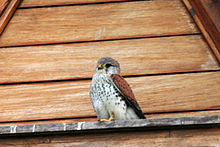Indian Ocean kestrels
| Indian Ocean kestrels | |
|---|---|
 |
|
| Madagascar kestrel (Falco newtoni) | |
| Scientific classification | |
| Kingdom: | Animalia |
| Phylum: | Chordata |
| Class: | Aves |
| Order: | Falconiformes |
| Family: | Falconidae |
| Genus: | Falco (partim) |
| Species | |
Isolated on various islands around the Indian Ocean, kestrel populations evolved into different species, like Darwin's finches. Behaviour remains similar to other small species of Falco (such as the common kestrel, Falco tinnunculus) except on (originally) forested Mauritius where kestrels hunt arboreally more like hawks. Due to the scarcity of mammals on oceanic islands, several species have adopted a diet containing many Phelsuma and other geckos. The species can be distinguished by coloration, but all except the banded kestrel share rich brown wings with black spotting. Sexes are alike in color except in the spotted kestrel, where differences are minor. As usual in birds of prey, females are larger than males; considerably so in some of these species as this assists resource partitioning.
Two subspecies of Madagascar kestrel, F. newtoni, are recognised, one on the main island of Madagascar and one on neighbouring Anjouan and Aldabra. It has adapted to human encroachment better than much of Madagascar's wildlife. Its diet is mainly lizards and insects. Confusingly it is sometimes referred to as the spotted kestrel, a name usually used for the Moluccan/Indonesian kestrel, while the Mauritius kestrel's scientific name literally means "spotted falcon/kestrel".
Its closest relative is the Seychelles kestrel, F. araea. Their ancestors diverged probably less than one million years ago (roughly around the early ) It is the smallest of all kestrels, otherwise similar to the Madagascar kestrel (and originally considered the same species). Its range is reduced to Mahé, with a few pairs on Silhouette Island, North Island and Praslin. Its diet is mainly lizards. The species' status, as the following one's, is Vulnerable according to the IUCN.
...
Wikipedia
